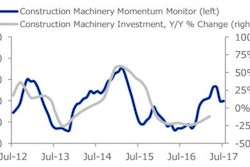
New business volume grew 2.5% in the equipment finance industry in 2016, according to the 2017 Survey of Equipment Finance Activity (SEFA) released by the Equipment Leasing and Finance Association (ELFA). The rise in new business volume marked the seventh consecutive year that businesses increased their spending on capital equipment. The SEFA report covers key statistical, financial and operations information for the $1 trillion equipment finance industry, based on a comprehensive survey of 115 ELFA member companies. The report is available at www.elfaonline.org/SEFA.
ELFA also released a companion report to the 2017 SEFA called the 2017 Small-Ticket Survey of Equipment Finance Activity. The report, which focuses on small-ticket and micro-ticket equipment transactions among the SEFA respondents, found that new business volume in the small-ticket space grew by 10.7% in 2016.
ELFA President and CEO Ralph Petta said, “The equipment finance industry continues a slow-growth trajectory, mirroring a fundamentally sound — if unspectacular — U.S. economy during the past several years. Despite a slowly rising interest rate environment, leasing and finance companies are profitable entities, with generally healthy portfolios and sustainable levels of returns.”
Key findings for 2016 as reported in the 2017 SEFA include:
Of industry new business volume in 2016:
- Construction equipment represented 8.7% of equipment financing new business volume reported by ELFA member companies, up from 8.1% in 2015.
- As an end-user of equipment finance, the construction industry represented 7.8% of new business volume reported by ELFA member companies, up from 7.3% in 2015.
Overall new business volume grew 2.5%. While this rate contrasts sharply with the 12.4% growth reported for 2015, the industry nonetheless outperformed the national economy, which grew just 1.6% in 2016, according to the U.S. Department of Commerce.
- By organization type: Independents saw a 12% increase in new business volume, while banks saw a 5% increase and captives saw a 5.9% decrease.
- By market segment: New business volume grew 5.2% in the middle ticket segment and 0.8% in small-ticket, while large ticket declined 1.8%.
From an asset perspective, the top-five most-financed equipment types were transportation, IT and related technology services, agricultural, construction and office machines. The top five end-user industries representing the largest share of new business volume were services, industrial and manufacturing, agriculture, transportation and wholesale/retail.
Assets under management rose by 13.9% overall, helped by increases in sales budgets and sales personnel, which reflected companies’ efforts to grow volume in an increasingly competitive environment. Return on assets also remained positive after declining by a percentage point to 1.4%, and balance sheets strengthened as net worth rose by 9.1%.
Interest expense increased year-over-year by 14%. The cost of funds decreased slightly.
Efficiencies gathered from increased automation and greater application of data analytics contributed to an overall year-over-year dollar increase in net income of 7.8%. Return on average equity fell for the third year in a row but remained positive at 11.8%.
Delinquencies increased slightly, with 1.8% of receivables over 31 days past due compared to 1.5% the previous year. Net full-year losses or charge-offs also increased slightly but remained at 0.29% of average receivables; any level lower than 1% is considered very low.
Credit approvals increased slightly while the percentage of those approved applications being booked and funded edged down overall.
Employment levels shot up 13.3% overall in 2016. This is likely the continued impact of the absorption of the GE Capital portfolio and personnel by the acquiring banks. Headcounts in accounting, tax and legal remained stable, reflecting the implementation of back-room efficiencies as companies continued their push to do more with less.
PricewaterhouseCoopers LLP administered the 2017 SEFA. The results were compiled from surveys sent to 375 eligible ELFA member companies in the first quarter of 2017. A total of 115 companies submitted 2016 U.S. domestic lease and loan data.

















